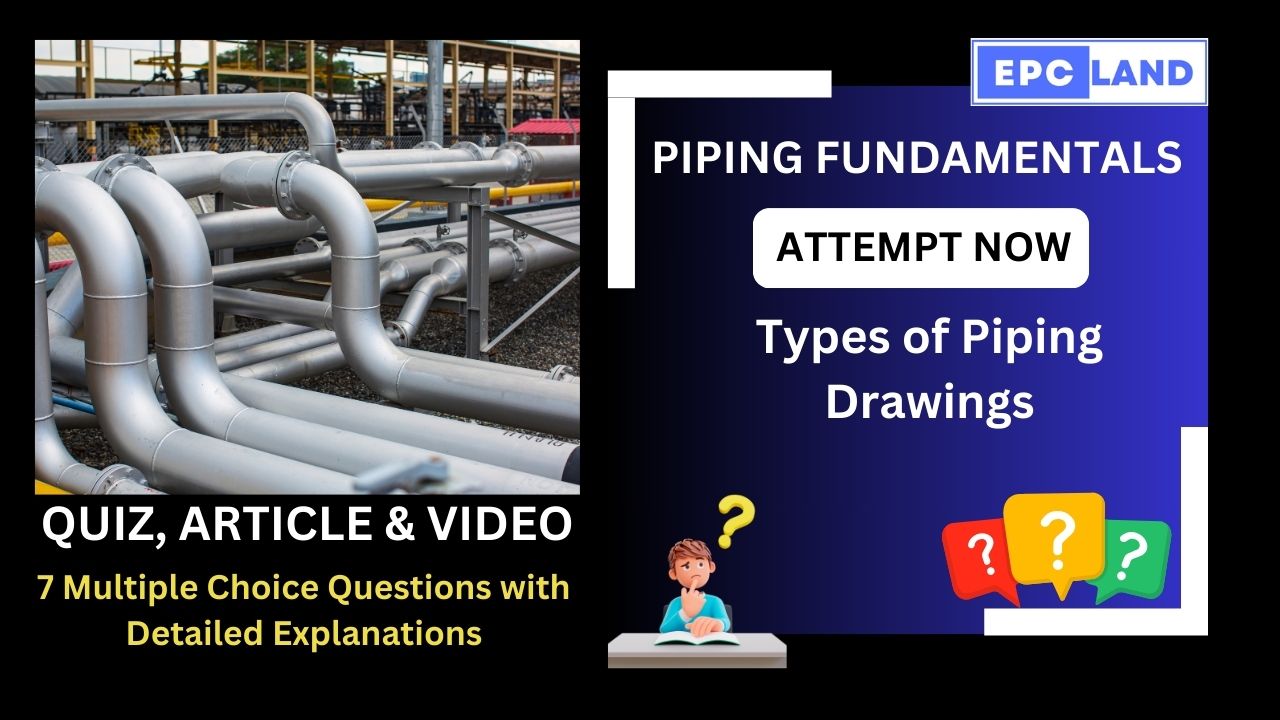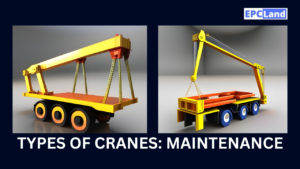1. What is the primary purpose of Piping Plan Drawings/General Arrangement Drawings (GAD) as one of the Types of Piping Drawings?
Choose the correct statement:
Explanation: Piping Plan Drawings/GAD illustrate the positioning of major equipment, the routing of pipelines, and essential elevations, establishing the framework for the piping system’s design.
2. What do Process Flow Diagrams (PFDs) (as one of the Types of Piping Drawings) primarily focus on?
Choose the correct statement:
Explanation: Process Flow Diagrams (PFDs) depict the intricate pathways that fluids take as they traverse the piping system, highlighting the equipment and processes involved.
3. What is the master Types of Piping Drawings or guiding the work of various engineering disciplines in a piping system?
Choose the correct statement:
Explanation: Piping and Instrumentation Diagrams (P&IDs) offer a comprehensive representation of the piping system, guiding the work of various engineering disciplines.
4. What is the purpose of Plot Plan Layout in piping drawings?
Choose the correct statement:
Explanation: Plot Plan Layout provides a panoramic view of the entire plant site, depicting the location of buildings, equipment, and piping systems within the overall site layout.
5. What does a Piping Isometric Drawing primarily present?
Choose the correct statement:
Explanation: Piping Isometric Drawings present a three-dimensional representation of the piping system, illustrating all piping components, dimensions, and supports.
6. What is the primary purpose of Piping Drawings in terms of fabrication?
Choose the correct statement:
Explanation: Piping Drawings enhance fabrication accuracy by providing fabricators with precise specifications for pipe sizes, materials, fittings, and valves.
7. What crucial role do Piping Drawings play in the maintenance of piping systems?
Choose the correct statement:
Explanation: Piping Drawings play a crucial role in maintenance by providing essential information for identifying piping components, troubleshooting issues, and implementing modifications as piping systems evolve over time.
Short Article on Types of Piping Drawings
Piping Drawing Basics for Engineering Companies: A Comprehensive Guide
In the realm of engineering, piping drawings play a pivotal role in the design, construction, and maintenance of piping systems. These intricate diagrams serve as blueprints, providing a visual representation of the intricate network of pipes that transport fluids throughout industrial facilities and power plants. By understanding the different types of piping drawings and their specific purposes, engineering professionals can effectively communicate design intent, ensure accurate fabrication, guide construction activities, and facilitate maintenance and modifications.
Types of Piping Drawings: Unveiling the Blueprint
The diverse world of piping drawings encompasses a range of specialized diagrams, each tailored to serve a specific purpose in the piping system lifecycle. Let’s delve into the five primary types of piping drawings that are essential for engineering companies:
- Piping Plan Drawings/General Arrangement Drawings (GAD): These foundational drawings provide a bird’s-eye view of the overall piping system layout. They illustrate the positioning of major equipment, the routing of pipelines, and essential elevations, establishing the framework for the piping system’s design.
- Process Flow Diagrams (PFD): Shifting focus to the flow of fluids, PFDs depict the intricate pathways that fluids take as they traverse the piping system. These diagrams highlight the equipment and processes involved, providing a simplified representation of the fluid’s journey.
- Piping and Instrumentation Diagrams (P&ID): Stepping into a more detailed realm, P&IDs offer a comprehensive representation of the piping system, incorporating all piping components, valves, instruments, and controls. These diagrams serve as the master document, guiding the work of various engineering disciplines.
- Plot Plan Layout: Expanding beyond the confines of the piping system, plot plan layouts provide a panoramic view of the entire plant site. They depict the location of buildings, equipment, and piping systems within the overall site layout, ensuring optimal space utilization and efficient plant operation.
- Piping Isometric Drawing: Diving into the intricacies of piping arrangement, isometric drawings present a three-dimensional representation of the piping system. These detailed diagrams illustrate all piping components, dimensions, and supports, providing a precise guide for fabrication and installation.
Purposes of Piping Drawings: A Journey from Design to Maintenance
Piping drawings serve as versatile tools, fulfilling a range of crucial purposes throughout the piping system’s lifecycle. Let’s explore the key objectives of piping drawings:
- Communicating Design Requirements: Piping drawings act as a bridge between the design team and other stakeholders, effectively conveying the design intent and ensuring a shared understanding of the piping system’s configuration.
- Enhancing Fabrication Accuracy: These detailed diagrams provide fabricators with precise specifications for pipe sizes, materials, fittings, and valves, ensuring the accurate fabrication of piping components.
- Guiding Construction Activities: Piping drawings serve as a roadmap for construction personnel, guiding the proper installation of piping components, supports, and equipment connections.
- Facilitating Maintenance and Modifications: As piping systems evolve over time, piping drawings become indispensable tools for maintenance personnel. These diagrams provide essential information for identifying piping components, troubleshooting issues, and implementing modifications.
Conclusion: A Foundation for Engineering Success
Piping drawings form the cornerstone of engineering expertise in the design, construction, and maintenance of piping systems. By mastering the intricacies of these diagrams, engineering professionals can effectively communicate design intent, ensure accurate fabrication, guide construction activities, and facilitate maintenance and modifications. As the pulse of fluid transport systems, piping drawings remain an invaluable asset in the realm of engineering.
Table of Contents
Don’t miss the Course on Effective Isometrics Management: Check Now
Enrollment Link
Recommended courses (Published on EPCLand)
- Complete Course on Piping Engineering
- Basics of Piping Engineering
- Piping Layout Engineering
- Piping Material Engineering
- Piping Stress Analysis
- Material Requisitions
- Piping Material Specifications
- Valve Material Specifications
- Plant Design & Layouts-OISD 118
- Isometric Management
Library of Technical Articles
Don’t miss out the collection of 15+ articles on following topics:
- Basics of Oil and Gas Industry
- Valves
- Testing
- Tank
- Piping Bulk Items
- Pipe
- Metallurgy
- Piping Materials
- Layout
- Instrumentation
- Heat Exchanger
- Type of Contracts
- Codes and Standards
- ASTM Standards
- Articles on Piping Specialty Items
Video details of Complete Course on Piping Engineering
Why Enroll in the EPCLand
Proven Track Record– PTR
Activities & Achievements before launching EPCLand
- Published more than 50+ short courses
- 3000+ Enrolments
- More than 3,500,00 Minutes of watch hours in the last 2 years
- 4000+ Students in 100+ Countries
- Rating of 4+ out of 5
- 1000+ YouTube Videos
- 8K+ Subscribers
What Students will Learn
- Codes & Standards of the Energy Sector
- Piping Material Engineering
- Piping Layout Engineering
- Stress Analysis
Interesting facts
- All the published courses have been developed by Industry Experts with more than 2 decades of experience
- Content is based on Practical experience and real-time problems.
- Content is designed and organized in such a manner that it can be easily grabbed.
- Complete website, Blogs and Quiz sections are Planned, Designed and published by myself (About me: Atul Singla)
- Complete flexibility of Time & Location, Students can access the content from anywhere & anytime
- Moreover, once enrolled, the content can be access as many times as you want, which helps in understand the fundamentals in a better way.
Conclusion
In conclusion, our courses are meticulously crafted by industry experts with over two decades of hands-on experience. The content is rooted in practical knowledge, addressing real-time problems. The material is thoughtfully designed and organized for easy comprehension. Every aspect, from the website to blogs and quizzes, has been planned, designed, and executed by Atul Singla, ensuring a comprehensive and seamless learning experience. With the flexibility of accessing the content at any time and from any location, students have the freedom to learn on their terms. Furthermore, enrollment grants unlimited access, allowing learners to revisit the material as often as needed, fostering a deep understanding of the fundamentals.



